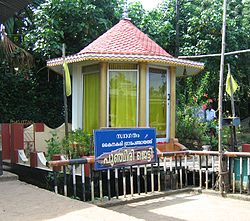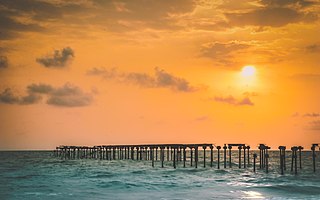
Alappuzha is one of the 14 districts in the state of Kerala in India.It is the smallest district in Kerala. It was formed as Alleppey District on 17 August 1957. The name of the district was officially changed to Alappuzha in 1990. Alleppey town was renamed Alappuzha in 2012, even though the anglicised name is still commonly used to describe the town as well as the district. The district is best known for its picturesque backwaters.

Kumarakom is a popular tourism destination located near the city of Kottayam, in Kerala, India, famous for its backwater tourism. It is set in the backdrop of the Vembanad Lake, the largest lake in the state of Kerala.

The Kerala backwaters are a network of brackish lagoons and lakes lying parallel to the Arabian Sea coast of Kerala state in southern India, as well as interconnected canals, rivers, and inlets, a labyrinthine system formed by more than 900 kilometres (560 mi) of waterways, and sometimes compared to American bayous. The network includes five large lakes linked by canals, both man made and natural, fed by 38 rivers, and extending virtually half the length of Kerala state. The backwaters were formed by the action of waves and shore currents creating low barrier islands across the mouths of the many rivers flowing down from the Western Ghats range. In the midst of this landscape there are a number of towns and cities, which serve as the starting and end points of backwater cruises.

Vembanad is the longest lake in India, and the largest lake in the state of Kerala. With an area of 2033 square kilometers, it is the second largest Ramsar site in India only after the Sunderbans in West Bengal. Spanning several districts in the state of Kerala, it is known as Vembanadu Lake in Kottayam, Punnamada Lake in Alappuzha and Kochi Lake in Kochi. Several groups of small islands including Vypin, Mulavukad, Vallarpadam, Willingdon Island are located in the Kochi Lake portion. Kochi Port is built around the Willingdon Island and the Vallarpadam island.

Ashtamudi Lake, in the Kollam District of the Indian state of Kerala, is the most visited backwater and lake in the state. It possesses a unique wetland ecosystem and a large palm-shaped water body, second only in size to the Vembanad estuary ecosystem of the state. Ashtamudi means 'eight braids' in the local Malayalam language. The name is indicative of the lake's topography with its multiple branches. The lake is also called the gateway to the backwaters of Kerala and is well known for its houseboat and backwater resorts. Ashtamudi Wetland was included in the list of wetlands of international importance, as defined by the Ramsar Convention for the conservation and sustainable utilization of wetlands.

Kuttanad is a region covering the Alappuzha, Kottayam and Pathanamthitta Districts, in the state of Kerala, India, well known for its vast paddy fields and geographical peculiarities. The region has the lowest altitude in India, and is one of the few places in the world where farming is carried on around 1.2 to 3.0 metres below sea level. Kuttanadu is historically important in the ancient history of South India and is the major rice producer in the state. Farmers of Kuttanad are famous for Biosaline Farming. Food and Agriculture Organization (FAO) has declared the Kuttanad Farming System as a Globally Important Agricultural Heritage System (GIAHS).

Kavalam is a village in Kuttanadu, Kerala state, Alappuzha District. India.

The Pamba River is the third longest river in the Indian state of Kerala after Periyar and Bharathappuzha and the longest river in the erstwhile former princely state of Travancore. Sabarimala temple dedicated to Lord Ayyappa is located on the banks of the river Pamba.

Alappuzha, also known by its former name Alleppey, is the administrative headquarters of Alappuzha District in the Indian State of Kerala. Alappuzha is a city and a municipality in Kerala with an urban population of 174,164 and ranks third among the districts in literacy rate in the State of Kerala. In 2016, the Centre for Science and Environment rated Alappuzha as the cleanest town in India. Alappuzha is considered to be the oldest planned city in this region and the lighthouse built on the coast of the city is the first of its kind along the Laccadive Sea coast.

Kerala State Water Transport Department (SWTD) is a governmental department that regulates the inland navigation systems in the Indian state of Kerala and provides inland water transport facilities. It stands for catering to the traffic needs of the inhabitants of the waterlogged areas of the Districts of Alappuzha, Kottayam, Kollam, Ernakulam, Kannur and Kasaragod. The department is headed by the State Minister in charge of transportation.
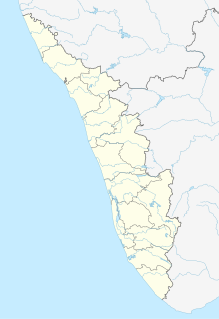
Pulincunnoo or Pulinkunnoo is an island village in the Kuttanadu region of Alappuzha district in the Indian state of Kerala. The Pampa river in Pulincunnoo is one of the most favored routes of the houseboats tourism operators in Kuttanadu. The village is part of the many islands dotting the famous Kerala Backwaters, a network of lakes, wetlands, and canals crisscrossing through the State. Pulincunno is notable for the annual Rajiv Gandhi Trophy snake boat race held during the months of October–November.
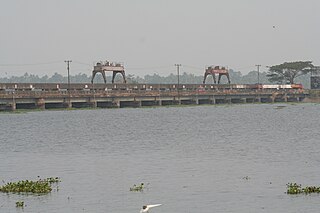
The Thanneermukkom Bund was constructed as a part of the Kuttanad Development Scheme to prevent tidal action and intrusion of salt water into the Kuttanad low-lands across Vembanad Lake between Thannermukkom on west and Vechur on east. Thanneermukkom Bund was constructed in 1974 and is functional since 1976. It is the largest mud regulator in India. This barrier essentially divides the lake into two parts - one with brackish water perennially and the other half with fresh water fed by the rivers draining into the lake.

The West Coast Canal or National Waterway No 3 is a 205-km stretch of this inland navigational route located in Kerala, India and runs from Kollam to Kottapuram and was declared a National Waterway in 1993. In addition to the main stretch, Champakara and Udyogmandal canals are navigable and connect the industrial centers of Kochi to Kochi port Inland Waterways Authority of India (IWAI) under the Ministry of Shipping is coordinating the task for developing, monitoring and administering national waterways. It is the first National Waterway in the country with 24-hour navigation facilities along the entire stretch. It has been extended to Kozhikode as per National Waterways Act, 2016. The National Waterway 3 is passing mainly through the alignment of ertswhile Thiruvananthapuram–Shoranur canal.
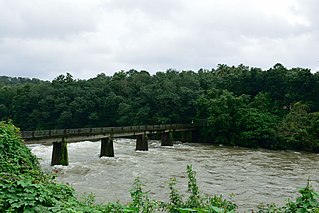
Manimala River is a 92 km long river in South and Central Kerala. The river used to be wrongly considered as a tributary of Pamba River before satellite maps became popular, but this is incorrect. Manimala does not flow into Pamba, but a branch of Pamba flows into Manimala from Kuthiathode and joins Manimala at Kallunkal, later branches out at again from Manimala at Nedumpuram and flows through Niranam, Thalavady, Edathua, Changankary, Champakulam, Nedumudy, Chennamkary, and finally Kainakary and empties into Vembanad lake. This branch again links with Manimala river at Chennankary in a short, but broad connection known as Munnattumukham. Manimala is a separate independent river for all geographical purposes. It has its origin on the Muthavara Hills on the Western Ghats, It is with a length of about 90 km and a catchment area of about 847 km2. in Idukki district of Kerala, India. The river passes through the districts of Kottayam, Pathanamthitta and Alappuzha districts. Yendayar, Koottickal, Mundakayam, Erumeli, Manimala, Kottangal, Kulathurmoozy, Vaipur, Mallappally, Keezhvaipur, Thuruthicad, komalam,/kuranjoor kadavuKallooppara, vallamkulam, Kattode & Kuttoor, Pulikeezh, Nedumpuram, Neerettupuram, Amichakary, Muttar, Kidangara, Pulincunnoo, Veliyanadu, Ramankary, Mankompu lie on the banks of Manimala River. Manimala splits after Kidangara into two branches. Second branch flows via Kunnamkary, Kavalam and Kainakary to Vembanad lake. Its running length is estimated at 92 km. It empties itself into the Vembanad Lake. It is one of the four major rivers which do not have direct outlet to sea as these rivers empty into the vast Vembanad lake. This huge lake has just two outlets, one at Thottappaly Spillway and second at Thannermukkom Bund, both man made barriers, built to prevent incoming seawater during high tides, which otherwise would render the low lying paddyfields uncultivable.

State Highway 11 is a State Highway in Kerala, India that starts in Kalarcode, Alappuzha and ends in Perunna, Changanassery.The road is popularly known as AC road road. The highway is 24.2 km long.

Kainady village is located in Neelamperoor grama panchayat in Alappuzha district of Kerala, India.
Pallithanam Luca Matthai was born in 1880 in Kainady village, Kuttanad, British India.

Kollam KSWTD Boat Jetty or Kollam KSWTD Ferry Station is an transport hub in the city of Kollam in Kerala, India, one of 14 ferry stations owned by the Kerala State Water Transport Department.
Chennamkary is a village in Kuttanad Taluk in Alappuzha District of Kerala state, India.
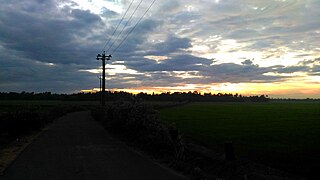
Kandankary is a small village in Kerala, India. It is located in Champakulam Panchayat in Kuttanadu Taluk. It is presumed that this region was a very big forest in ancient years, but later destroyed by a forest fire. It is still possible to see "kari" (coal) if we dig deep into the soil. So this place name end-up with Kari. The main source of income is agriculture. The rice fields are a key feature of the place. The village is located on the banks of the Pamba River.
